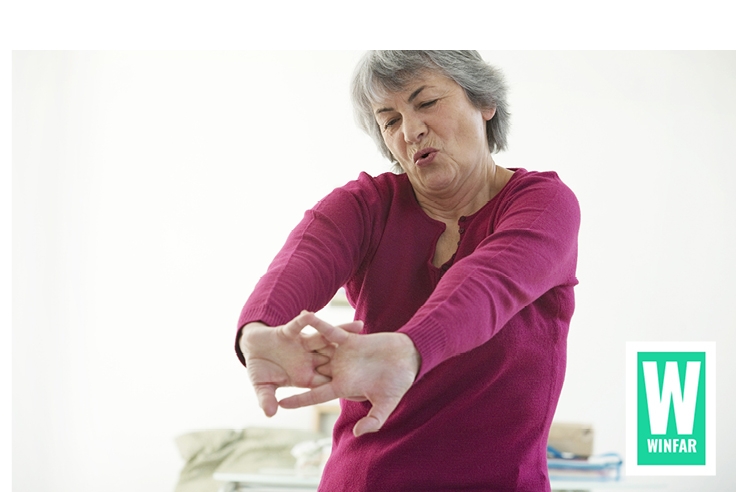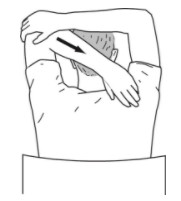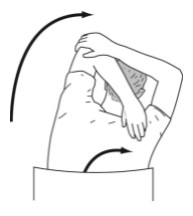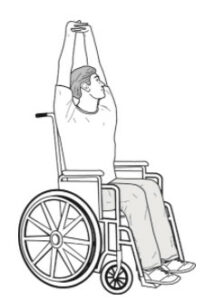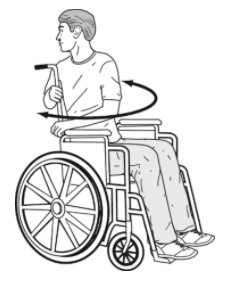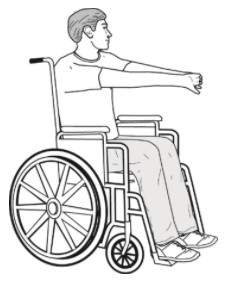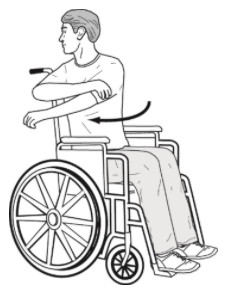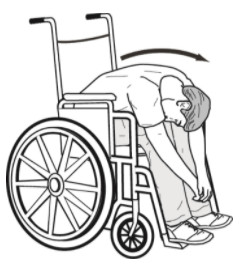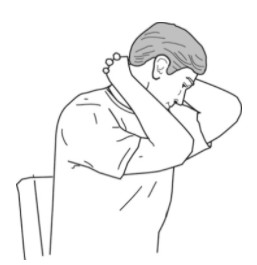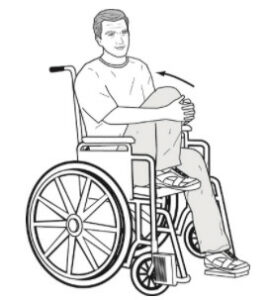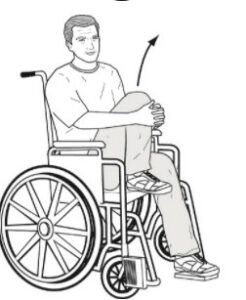So you think stretching is the domain of the young and flexible? Think again.
In a chair or out, young or old, we all need flexibility to maintain the range of motion we enjoy. Just because you are older, or less agile, or mobility restricted, doesn’t change your bodies design or it’s needs.
Regular stretching keeps muscles healthy, long, lean, and flexible.
Healthy muscles help maintain balance and prevent falls. Failure to stretch, by contrast, causes the muscles to shorten and become tight. Reducing and inhibiting movement, affecting balance, self-confidence, and quality of life.
The importance of stretching
You don’t need to have full mobility to experience the health benefits of stretching. Just a few stretches daily, reaps a world of reward.
The benefits of stretching include:
– reduced muscle tension,
– increased circulation,
– increased range of movements,
– increased blood flow to various parts of the body, and
– increased energy levels from the improved circulation, which means improved physical performance, and reduced risk of injury.
Add to that it releases endorphins that energize your mood, relieve stress, boost your self-esteem, and trigger an overall sense of well-being. Something we can all do with a little more of.
The importance of stretching for wheelchair users
Stretching is especially important for people who use wheelchairs. Pushing your wheelchair is, in fact, a form of exercise. One that puts focused repetitive pressure on specific muscles in the upper body, making strains and or other injuries more likely. Stretching reduces the risk of injury, helping your body prepare for the task you are expecting it to perform, and to perform that task more efficiently, with less strain.
Benefits of stretching when you’re a wheelchair user
1. Protecting joints
Stretching protects and strengthens your joints. Regardless of your type of disability or your level of mobility, stretching for 5-10 minutes before you start your day, helps protect your joints.
If you’re unable to stretch yourself, ask a family member or a health professional to help. Everything is possible with a little help.
2. Improve circulation
Stretching has also been shown to help improve circulation, which is especially important for people in wheelchairs, who experience limited mobility. Our bodies are just not designed to be in a seated position for extended periods of time. Stretching helps. It boosts blood flow, to all areas of the body, including the brain. And by so doing, slows down, postpones, and in some cases even entirely prevents bedsores from developing on the areas of your skin that are under prolonged periods of increased pressure.
In fact, you can even take it even one step further. Start your day, by stretching out fully in bed. While horizontal, with pressure evenly distributed throughout the whole body – stretch all the key areas of your torso and legs to their maximum ability. That alleviates any built-up tension and muscle discomfort stored in the body from the preceding day before you start the day
3. Helps manage stress
The more you stretch, the more you reduce the tension in the muscles, the more you increase your blood flow and relax your whole body. You will not only feel better but your energy levels will be increased, which in turn affects your outlook and quality of life.
How to Exercise with Limited Mobility
Don’t let your limitations get in the way. Just start with one or 2 simple chair exercises, done daily.
As your strength and confidence increase, you can reassess. The point is, for now, just to start.
Below are several well-illustrated exercises in Stretching Exercises for Wheelchair Users, from The Ohio State University. These types of exercises are simple to perform and do not require any assistive equipment.
A word of caution
Before you commence your new stretching regime, first talk with your doctor. Your doctor or physical therapist will be able to evaluate your physical capabilities and offer professional guidance on suitable stretches for your specific mobility limitations.
Caution should always be taken before beginning any exercise or physical movement program. This is especially true for anyone who has limited mobility and/or ongoing medical conditions.
Be careful, take it easy and start slowly. Never bounce into a stretch Bouncing (or, rocking back and forth while stretching) might injure delicate muscles. It is best to focus on breathing and to stretch slowly, without forcing any movements.
Stretching Exercises for Wheelchair Users
As a starting point, especially as a wheelchair user, it is recommended you focus your efforts on both your upper and lower extremities.
Your upper extremities, in perpetual use, are at increased risk of shoulder injury due to overuse.
And your lower extremities especially your quads and hamstrings, need stretching. Wheelchair users are at risk of developing serious conditions from contracted muscles. Plantar fasciitis, for example, is a condition that makes it difficult to place your feet flat. Since you do not actively stretch these muscles or provide blood flow to your lower extremities by walking, you need to be vigilant about stretching.
The Hip Flexor Stretch is a critical component of your stretching routine.
1. Elbow pull
- Hold your left elbow with your right hand.
- Gently pull your elbow behind your head until an easy stretch is felt in your shoulder or the back of your upper arm (triceps).
- Repeat exercise for your other arm
image source: https://www.healthwise.net
2. Elbow pull and lean
- Begin with the same stretch as above, now gently pull your elbow behind your head until an easy stretch is felt.
- Gently lean sideways from your hips to stretch along the side of your upper body.
image source: https://www.healthwise.net
3. Palms up
- Interlace your fingers from one hand with those of your opposite hand.
- Raise your arms above your head with your palms facing up.
- Push your arms slightly back and up. Feel the stretch in your arms, shoulders and upper back.
image source: https://www.healthwise.net
4. Over the shoulder
- Keeping your hips straight ahead in the chair, turn your upper body to the right and then to the left.
- Turn so you are looking over your shoulder. This exercise will create a stretch in your back and sides.
image source: https://www.healthwise.net
Caution: Persons with spine-stabilizing hardware, such as Harrington Rods, may be restricted in twisting. Persons with chest or back injuries should have their doctor’s approval before doing this exercise.
5. Palms forward
- Interlace your fingers with your palms facing out and your arms extended out in front of you at shoulder height.
- Extend your arms forward to stretch your shoulders, mid-upper back, arms, hand, fingers and wrists.
image source: https://www.healthwise.net
6. Elbow across
- Pull your elbow gently across your chest toward your opposite shoulder until you feel a comfortable stretch.
- Repeat with your other elbow.
image source: https://www.healthwise.net
7. Shoulder shrug
This stretch is good for relieving stiffness and tension in the shoulders and neck.
- Pull the top of your shoulders up towards your earlobes and hold for 5 to 8 seconds.
- Relax completely and allow your shoulders to drop down naturally.
- Repeat this several times.
8. Head tilt
- Use good posture while sitting in the chair.
- Tilt your head to the left side, and at the same time, allow your right shoulder to move downward. This will create a stretch along the side of your neck.
- Repeat on the other side.
9. Forward body bend
- Bend forward to stretch the areas from your neck through your lower back. This is also a good weight shift position and may be done with a pillow on your lap.
- Find a comfortable position and hold it for about 1 to 2 minutes.
- To sit up, put your hands on your thighs and push your upper body to an upright position.
image source: https://www.healthwise.net
10. Shoulder blades together
- Interlace your fingers behind your head, keeping your elbows straight out to your sides. Keep your upper body in an upright position in the center.
- Pull your shoulder blades together to create a feeling of tension through your upper back and shoulder blades.
- Hold this tension for 8 to 12 seconds and then relax.
- Repeat several times.
11. Neck stretch
- Sitting in an upright position in the center of your chair, interlace your fingers on the back of your head.
- Gently pull your head down until your feel a slight stretch in the back of your neck.
image source: https://www.healthwise.net
Caution: Persons with cervical spine injuries should have their doctor’s approval before doing this stretch.
12. Knee to chest
- Pull your knee toward your chest until your feel an easy stretch.
- Hold this easy stretch until the tension disappears, and then stretch a little further until you feel a mild, comfortable tension again.
- Repeat for your other leg.
image source: https://www.healthwise.net
13. Knee across
- Pull your knee across your body toward your opposite shoulder to stretch the outside of your upper leg.
- Hold this for 30 to 40 seconds.
- Repeat for your other leg.
image source: https://www.healthwise.net
DISCLAIMER: This website does not provide medical advice. This information, including text, graphics, images, and other material contained on this website is for information purposes only. No material on this site is intended to be a substitute for professional medical advice, diagnosis, or treatment. Always seek the advice of your physician or other qualified health care provider with any questions you may have regarding a medical condition or treatment before undertaking a new health regime, and never disregard professional medical advice or delay in seeking it because of something you have read on this website.
Source: September 29, 2022, The Ohio State University Wexner Medical Center
https://www.healthwise.net/osumychart/Content/StdDocument.aspx?DOCHWID=custom.hs0071
Additional sources:
https://pushliving.com/stretching-benefits-wheelchair-users/
https://www.mayoclinic.org/healthy-lifestyle/fitness/in-depth/stretching/art-20047931
https://www.hoveround.com/articles/the-benefits-of-safe-power-wheelchair-stretching
https://www.health.harvard.edu/staying-healthy/the-importance-of-stretching
https://www.helpguide.org/articles/healthy-living/chair-exercises-and-limited-mobility-fitness.
https://www.healthwise.net/osumychart/Content/StdDocument.aspx?DOCHWID=custom.hs0071

